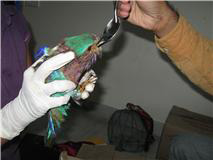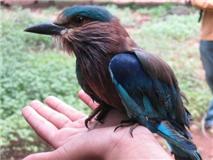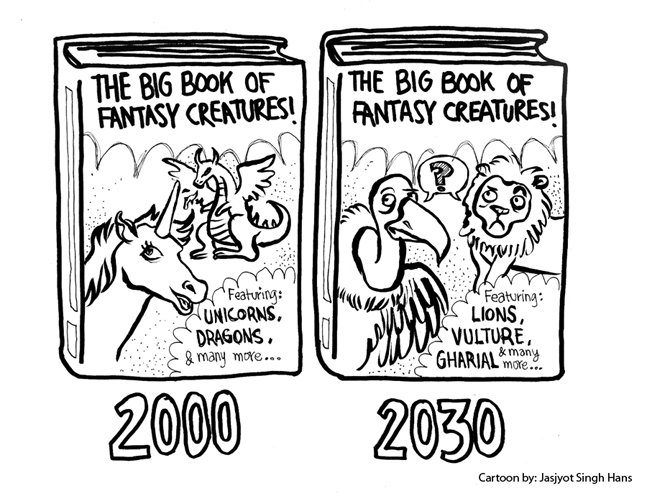Burning Issues
Blue Hues of The Blue Jay
- Nita Paropkari
The Indian Roller a.k.a Neelkanth,Paalapitta and Blue Jay, is a very common bird. Ranging from the foothills of the Himalayas to Sri Lanka in the south, they are found in cultivation areas and light forest regions.
When the world was being formed by the churning of the ocean, the poison that came out first was swallowed by Shiva and he was known as Neelkanth , or blue throated as the poison turned his throat blue. The Neelkanth is regarded as the bird of Shiva and hence
its name. The bird is sacred (right!). In another tale, a very long time ago,the Kings used to release captive Indian Rollers on the eve of Dussera to signify the victory of good over evil. And yet another -When Lord Rama embarked upon his journey to kill
the evil Ravana,he spotted the Blue Jay. His victory is attributed to the sighting of the bird.
Farmers in our country hold the Roller in equal reverence because of its ability to be a superior pest controller, specially in regions of low rainfall. They walk miles to spot this bird during ten days of dussera,if they didn't see one in their own fields.
All the very same reasons make it auspicious to view the bird on Dussera day,for which poachers capture this bird weeks in advance and frequent the streets of Hyderabad and probably every other city and town to make a quick buck (as is human nature to exploit
anything and everything for money).

I first saw a striking flash of blue accompanied by a loud screeching..,not just blue,too many blues.There were so many different shades of blue on that bird, more blue when the wings spread,flapping relentlessly on the sides of the rusty cage. Such a huge
wing span for a tiny bird was my second thought. My focus shifted to the face of the bird..it was clearly confused, tired and in pain and still screeching, yet it looked elegant and royal. I realized it wasn't admiring me the way I was admiring it...I wanted
to yell at that man, tell him a thing or two about putting a big bird in a small cage like that, but quietly walked away and confirmed to my fellow volunteers that the man indeed had a Roller. Acting quickly,the male volunteer then held the man while I and
my friend siezed the cage from his hand and left..The poacher didn't protest or fight with us probably because he knew what he was doing is against the law.
We took the Roller to the shelter,perched it on a twig in a caged-room ,saw it drink water and left. We rescued 6 more paalapittas that day. Two of them were females,which are more of brown than blue, but were colored blue with greasy paints,so that they look
blue,Like the throat of Lord Shiva when he drank the poision. It was tough for the vet getting all that paint off them. The whole thing is tougher for the bird though.
Since then, I have volunteered to help rescue these birds every Dussera and thanks to the dedicated organisations in Hyderabad,the number of poachers bringing them to the city has depleted significantly. I dont know how many of the rescued birds survive the
trauma and how many actually die while being trapped and transported. Its wrong for people to exploit a tradition or a legend.

( Photograph and text by Nita Paropkari, who is with People for Animals, Hyderabad)
Comments by Prajakta Hoshangabadkar who is aggregating stories under "Green Defenders" for IndianWildlifeClub.com
Nita and her team have really done a great job. Blue jay comes in a Indian wildlife protection act schedule 3, capturing a bird for selling is punishable. Blue jay is commonly found on wire fencing of the farmers' fields. It mostly feeds on pests ,insects
in the which agricultural crops. It means blue jay is a friend of the farmer, a bird which protects their crop from harmful pests and insects. Need to stop customs and practices which are destroying beautiful as well as important creation of nature. If
we can’t create then we don’t have right to destroy too….
|
Burning Issues
Jasjyot Singh Hans is an Animation Film Design student at NID, Ahmedabad. His interests
include illustrating and reading graphic narratives. He is also environmentally aware and
concerned, like any thinking young man/woman of today is. His take on 'extinction' looming large over a large number of species, is humorous but also thought provoking.

Here is an excerpt from a report published in http://www.arkive.org
One in five vertebrate species are threatened with extinction according to a landmark study
launched by the IUCN on Wednesday 27th October 2010 at the Conference of the Parties to the Convention on Biological Diversity (CBD), in Nagoya, Japan. The timely study, which is the most comprehensive assessment of the world’s vertebrates to date, confirms
our fears that across the globe vertebrates are experiencing an extinction crisis. However, it also confirms that the situation would be a lot worse if not for conservation efforts.
" The study, which involved some 174 authors from 115 institutions and 38 countries, with
voluntary contributions from more than 3,000 scientists, is published in the international
journal Science, and used the IUCN Red List of Threatened Species to investigate the status of around 25,000 vertebrate species and how this status has changed over time. The results reveal that, on average, 50 species of mammal, bird and amphibian are pushed
closer to extinction each year. The situation has been most stark in Southeast Asia where many species are threatened by habitat loss due to the planting of crops like oil palm, deforestation by commercial timber operations, agricultural conversion to rice
paddies, and unsustainable hunting.
The study largely focused on vertebrates, but also reported that several other groups of
species assessed by the IUCN face a similar fate. The ancient group of plants known as cycads are in a particularly critical state with 63 percent of assessed species threatened with extinction, largely due to extremely high levels of illegal harvesting and
trade. Dragonflies and reef-building corals also did not fare well, with 13 and 33 percent of assessed species threatened with extinction respectively.
It is not all doom and gloom, however, as the study also reveals the positive impact of
conservation efforts for the first time, with the results suggesting that the status of
biodiversity would have declined by at least an additional 20 percent if conservation action
had not been taken. There are encouraging stories of 64 mammal, bird and amphibian species that have improved in status due to successful conservation action."
|